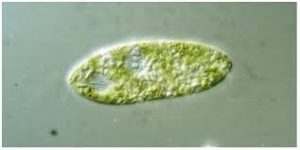Euglena : New Study

In India, Euglena and its relatives are now widespread indicators of deteriorating water quality.
- Euglena is a unicellular, flagellated microorganism belonging to the group Euglenophyta.
- These are commonly found in stagnant or slow-moving freshwater ponds, ditches, and urban lakes.
- These protists are highly adaptable, capable of both photosynthesis (like plants) and feeding on organic matter (like animals).
- This flexibility helps them thrive in nutrient-rich, oxygen-poor environments.
- Three of the most common euglenoid genera observed in Indian water bodies are: Euglena, Phacus, Trachelomonas sp. These species often dominate surface waters, especially during warmer months.
- The striking red or pink colour seen during blooms is due to a pigment called astaxanthin, produced by many euglenoids.
- Astaxanthin is a fat-soluble xanthophyll that gives these organisms their bright red colour.
- Impact of Euglena on Biodiversity:
- Oxygen depletion: Euglena photosynthesises, but at night it consumes oxygen, leading to diurnal oxygen fluctuations. This can result in hypoxia (low oxygen levels), which is dangerous for fish and other aquatic life.
- Dense surface scums: Euglenoid blooms form thick mats on the water surface, which block sunlight from reaching submerged plants. This reduces the lake’s productivity and alters its ecological balance.
- Fish mortality: Euglenophyte blooms can stick to fish gills, making it hard for them to breathe. Some species also produce toxins like euglenophycin, which directly kill fish or indirectly affect them by disrupting the food chain and oxygen levels.




